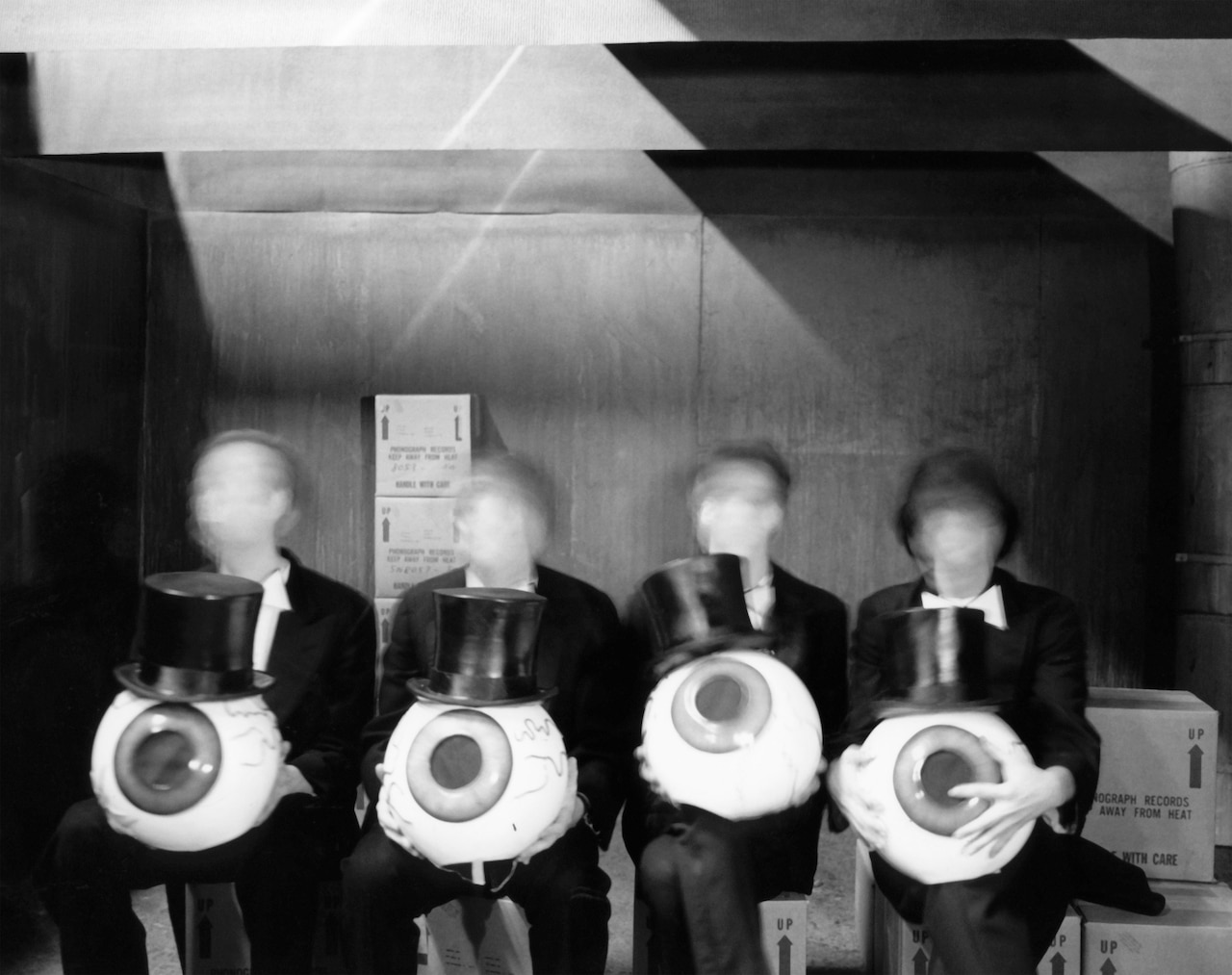A Guide to The Residents
On a Saturday afternoon in early June, the sidewalk outside the historic TLC Chinese Theatre in Hollywood is teeming with street performers dressed as pop culture icons. Spider-Man, Marilyn Monroe and Elvis mingle with tourists. A man in an old-timey paper hat sells popsicles from a cart, standing atop a courtyard embedded with cement handprints from the likes of Steven Spielberg and the Marx Brothers. Meanwhile, in the lobby of the theater, dozens of people are lining up to see a documentary about a band of timeless figures of a more underground stripe.
The movie is called Theory of Obscurity: A Film about The Residents, and as the title suggests, it covers the sprawling, 40-plus year history of one of America’s weirdest musical groups. Based out of San Francisco, The Residents moved from humble beginnings in their hometown of Shreveport, Louisiana, and became celebrated for their groundbreaking experiments in avant-garde music, electronic composition, sonic storytelling, and multimedia. Throughout, the Residents have rejected the usual trappings of the rock star persona, opting instead to preserve their mystique and independence through anonymity, misdirection and giant eyeball-and-top-hat masks.

Doing justice to a band with this much history is a challenge for any documentarian, but Theory of Obscurity, which was directed by Don Hardy, does its best to sum it all up. Given unprecedented access into the Residents’ world, he tells the band’s story through rare footage, quirky editing tricks, and interviews with friends, fans and longtime associates of the group. This includes veteran representatives of the Cryptic Corporation, the company that has long managed the group’s affairs (some of whom, experts suspect, are Residents themselves).
Unfortunately, Theory of Obscurity makes no attempt to unmask or even humanize this mysterious combo and glosses over many of their greatest achievements. By the end, some viewers might be left with the impression that the Residents – for all of their independence, entrepreneurialism and bold experimentation – are merely a band of kooky weirdos. But in a country like America, built on myths, beliefs, and outright lies, the Residents are just as meaningful as the rest of our heroes. It’s just that unlike so many others, they’re willing to confront the darkness and weirdness that lurks beneath the surface.
What follows is a brief look at some of their greatest albums.
The Third Reich ‘n Roll (1976)
A two-track, 35-minute blitzkrieg of anti-pop terror, Third Reich ‘n Roll stands as not only the Residents’ most infamous release, but also one of the greatest Top 40s takedowns of all time. The cover depicts Dick Clark of American Bandstand in full Nazi regalia. A promo video for the record shows the Residents dancing around in KKK hoods fashioned out of newspapers. The album is divided into two extended medleys – ”Swastikas On Parade” and “Hitler Was a Vegetarian” – in which the band serves up hideous reinterpretations of such pop classics as “Light My Fire,” “It’s My Party” and “In-A-Gadda-Da-Vida.”
The underlying message behind Third Reich ‘n Roll could’ve come straight from the dialectics of Theodor Adorno: mainstream pop music is a tool to appease the masses and prep them for the rise of totalitarianism. Thus, the Residents adopt a scorched earth strategy to raise the listener’s consciousness – rendering ditties like “Rock Around the Clock” unlistenable through keyboard-mashing dissonance.
Despite the album’s brutal parodies, it’s also full of thrilling avant-garde ideas. Hints of Sun Ra and Captain Beefheart show through in the atonal keyboard parts and chum-bucket riffs, while the use of tape splicing and collage harks back to early 20th century musique concrète – and anticipates the sampling of the future. Did the Residents end up saving the world from pop subjugation with this one? Not by a long shot, but it was still well worth the effort.
Not Available (1978)
The eyeballed ones rarely put out an album without an elaborate concept or backstory to back it up, and they set a pretty high bar for this early on with Not Available. This peculiar five-song suite was released in 1978 amidst a hoax-laden press campaign for their album Eskimo. According to legend, the actual music on the album was recorded four years earlier under the influence of the Residents’ elusive Bavarian guru, N. Senada. Senada was a composer and music theorist, and many of his theories played a key role in the Residents’ evolution (though many also suspect that Senada was merely a product of the band’s imagination). Particularly important was his “theory of obscurity,” which posited that artists are at their most pure when they’re working in secrecy – free from the influence of audiences and outside agents.
For Not Available, the Residents took this concept to an absurd extreme, refusing to release the album only until after they’d forgotten it existed (hence the title). Of course it’s hard to say what’s true and what’s fiction in the world of the Residents; maybe they were just waiting for the right moment to put it out.
Either way, this is a powerful release from the group, mixing hypnotic instrumental parts – pulsing drum machine beats, skronking horn riffs, winsome melodic figures plunked out on what sounds like an old schoolhouse piano – with the Residents’ weird, eerily cartoonish voices and cryptic narratives that were characteristic of their early years.
Commercial Album (1980)
Experimentally inclined and classically untrained, the Residents evolved by making music their own way. From the beginning they were guided not only by N. Senada’s “theory of obscurity,” but also by his “theory of phonetic organization,” which held that musicians should shape their work not by adhering to traditional structures or literal meanings, but through the use of raw sound.
It’s an ingenious notion – echoing the DIY ethos that eventually came to define punk and indie rock. But as the Residents got better at their instruments, they began to play around with the conventions they once rejected, and a combination of formalist approach and out-there exploration makes for surprising results in Commercial Album.
This delightful, 40-track record ostensibly serves as a collection of otherworldly radio jingles – each track lasts only a minute long, and each one more or less mirrors the verse-chorus structure of a standard American pop song. Still, the Residents make sure to put their own spin on things, delivering an epic sample platter of quiet reflections (“While We Were Young”), soulful trip-outs (“Love Leaks Out”), delirious noise jams (“The Coming of the Crow”) and psychedelic confections (“Moisture”). The album benefits greatly from the contributions of Henry Cow’s Fred Frith and Chris Cutler as well as longtime Residents collaborator Philip “Snakefinger” Lithman – so nicknamed for his supple guitar style. But more importantly, it shows the Residents in a more mature position, eager to forge something new out of the twisted skeleton of popular music.
The Mole Show Live in Holland (1983)
In the annals of Residents mythology, the story of the “Mole Trilogy” is especially legendary. The first thing you should know is that this is technically not a trilogy – only Parts One, Two and Four were ever made (1981’s Mark of the Mole, 1982’s The Tunes of Two Cities, and 1985’s The Big Bubble). The conspicuous absence of Part Three might have something to do with the disastrous Mole Show tour of 1983. After more than a decade of putting out records, the Residents had finally resolved to hit the road on a U.S. and European tour. Unfortunately, their colossal ambitions got the best of them and the live show turned out to be financially ruinous for the group, the Cryptic Corporation and their label, Ralph Records.
Nevertheless, the Mole Show was an incredible artistic achievement – that much is obvious on this live album. In it, the “lead” singing Resident (recognizable via his thick, expressive Louisiana drawl) is accompanied by murky synths and primitive beats as he sings about the runty, hard-working Mole people. Forced to escape their subterranean home after it’s wrecked by a flood of Biblical proportions, the Moles march across the desert and end up in the land of a lazy people called Chubs, who proceed to exploit the Moles for their cheap labor and then cast them off when they’re no longer needed.
Though the album’s bleak mood is leavened somewhat by the quirky narration of Residents associate Penn Jillette (sample commentary: “Well, that was kind of flashy in a low-tech sort of way…”), The Mole Show serves as a powerful allegory for the economic struggles of the Great Depression, and resonates even today amidst America’s divisive immigration debates.
God in Three Persons (1988)
Every Residents lover has a different favorite album, but many would agree this is the group’s masterpiece. A dramatic conceptual opera, God in Three Persons is filled with brass and woodwinds and guided by a one-woman Greek chorus in the form of singer Laurie Amat.
The story follows an unseemly fellow named Mr. X as he falls in with a pair of Siamese twins who possess supernatural healing powers and a Christ-like affinity for the downtrodden. They rove from town to town, impressing locals with a pyrotechnic live show that cures the mute and disabled of their ailments. Eventually, though, things go awry when Mr. X tries to violently consummate his sexual urges.
God in Three Persons’ DNA is all-American. Its main melodic theme is borrowed from The Swingin’ Medallions’ 1960s party anthem “Double Shot (Of My Baby’s Love)” – which the Residents had previously lampooned on Third Reich ‘n Roll – and the story, narrated by the “lead” Resident in a lilting, rhyming monologue, mirrors countless manipulative showbiz managers and Bible-thumping false prophets.
God in Three Persons makes for a dark exploration of the relationship between pleasure and pain. But more importantly, it taps into America’s enduring love for faith, mythmaking and public spectacle. As the lead Resident sings at the end: “All our lives we love illusion, neatly caught between confusion and the need to know we are alive.”
Demons Dance Alone (2002)
On Meet the Residents, the oddball foursome’s debut album from 1974, the Residents introduce themselves with a twisted rendition of Nancy Sinatra’s “These Boots Are Made for Walkin’” – replete with goofy vocals and farting horns. Nearly 30 years later, the Residents maintain their bizarre approach on Demons Dance Alone, serving up a high-concept effort riddled with symbolism and the usual strange characters.
And yet while the sound quality is better this time around, and the keyboards and guitars brighter in tone, the Residents don’t sound so plucky anymore. “I was watching Ivanhoe / When they said the tornado / Blew your big old house apart,” Molly Harvey – a crucial Residents member/collaborator throughout the 1990s and ‘00s – sings in “The Weatherman,” her voice weary with sadness.
The Residents never address current affairs directly, but in Demons Dance Alone they delve into the emotional turmoil wrought by the September 11th attacks. On tracks like “Ghost Child,” “Mickey Macaroni” and “Beekeeper’s Daughter,” they face feelings of loss and denial. At one point they’re dreaming about how life could just be a little bit more wonderful; at another they’re getting their mind off the pain with a quirky instrumental interlude. It’s just one of the many examples of what makes this group so fascinating. The inattentive listener might think the Residents exist far outside reality. But in fact they’ve been with us all along, laboring for years to conjure up their own beautiful and warped vision of the human experience.

